WW2 German Destroyers
 Germany (1930-44) circa 50 ships
Germany (1930-44) circa 50 ships
Foreworld: German expertise on destroyers proceeded from humble beginnings: The weak TBs from 1910-1914, barely fit for the high seas. However the influence of Royal Navy designs and an order from the Russian navy before the war gave the experience of large, well armed oceanic destroyers. In particular, the “Russian” B97 and G101 class and the S113 class. For more see German destroyers of ww1. This development was halted and all these ships had to be conducted to Scapa Flow for internment, and Versailles treaty conditions later only allowed for a police fleet for the Reichsmarine of 12 destroyers and 12 torpedo-boats. The “destroyers” were still very much of ww1 style, 1300 tons fully loaded, six built of the 1923 type and six of the 1924 types, all reclassed as TBs after the Z1 was launched. Their lineage was the basis for more modern torpedo-boats of the 1935 class with their flush-deck hull. 36 were built, plus 30 more in Dutch and German yards, mostly unfinished. But that’s another story.
There was a rebirth after the arrival of Hitler, and the first 1933 design was based on the D106 class of 1918. These were equal, if not superior to the best allied designs of destroyers leaders, with solid hulls for the north sea and reliable turbines. Soon, classed armed with cruiser-size artillery will be launched. All were denominated “Z-” (for “zestörer”), together with proper namesakes. Z1 Leberecht Maas (launched 1935) was followed by three sister ships, followed by the 1934A class (twelve units) 1936 class (six) and 1936A class (six) others being scheduled until 1946: The 1936B, 1936C designs, the smaller 1942 class, large 1944 class, and the super-destroyers of the 1940/41 class.
Interwar 1923 class
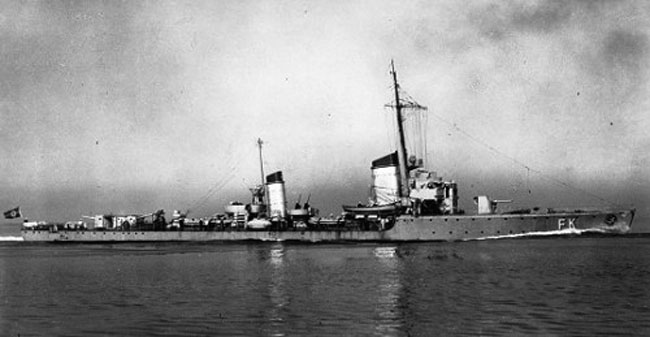
Falke, of the Albatross class, as built.
These small vessels were inspired by the S113 and B114 design. They had a raised forecastle, two funnels far apart, three 105 mm partially under masks and two banks of three 500mm TTs. AA artillery consisted in two 20mm guns. The 1923 type were all but Albatross (Schichau) built in Whilhelmshaven, laid down in 1924-25, launched in 1925 and completed and commissioned in 1926-28. They were named after birds of prey (“Raubvogel”), Möwe (which tested a rounded bow, all the others had transom sterns), Greif, Seeadler, Albatros, Kondor, and Falke. In 1931 they were standardized with the 533 mm TTs, and funnels were shortened while the control and superstructure were modified and enlarged. Their old 105mm/45 C16 were replaced by C28 and C32 models. By 1944 they had received radars and their AA artillery was augmented to seven C38 guns (one in quad mount, three singles). They served heavily and were all lost in action: Albatros by artillery duel inh Oslofjord in 1940, Seeadler off Boulogne (Torpedoed by British MTB) in 1942, Greif bombed by the RAF in 1944 off Cherbourg as well as the remainder in Le Havre.

Möwe in April 1944
1923 type specifications |
|
| Dimensions | 87.7 x 8.25 x 3.65 m |
| Displacement | 923/1290t FL |
| Crew | 127 |
| Propulsion | 2 shaft geared Blohm & Voss turbines (Albatross: 3 boilers) 24,000 hp |
| Speed | 33.6 knots (62.2 km/h; 38.7 mph), 1,700 nmi (3,100 km; 2,000 mi) |
| Armament | 3x 105 mm, 3x 20mm AA, 6(2×3) TT 500 mm |
Interwar 1924 class
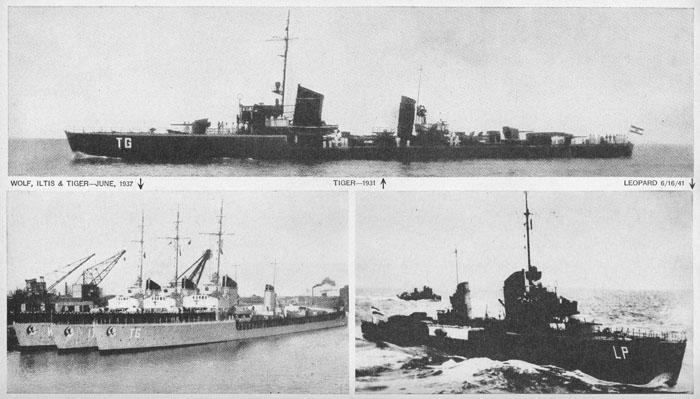
Several ships of the type
These six ships named after predators or “Raubtier” (Wolf, Itlis, Jaguar, Leopard, Luchs, Tiger) were slightly enlarged versions of the former, longer, wider, slightly more powerful with new shaft-geared turbines and more modern 105mm/45 C28 guns. They were built at the same yards but completed one year later in 1928-29. In 1931 they received the same modifications, new TTs, new superstructure, sights and fire control systems. However Leopard and Luchs were rearmed three 127mm/45 C34 guns, testing these for the new class of destroyer. Past 1943 the remainder received eight 20mm AA guns. All six were lost in action but Tiger in 1939 and Leopard because of collisions, Luchs torpedoed by HMS Swordfish in 1940, Wolf mined off Dover in 1941, Itlis by a MTB off Boulogne in 1942, and Jaguar bombed at le Havre in 1944 by the RAF.

Jaguar in 1942
1924 type specifications |
|
| Dimensions | 92.6 x 8.65 x 3.52 m |
| Displacement | 932/1300t FL |
| Crew | 127 |
| Propulsion | 2 shaft geared B&V/Schichau/Brown-Boveri turbines, 3 boilers, 25,500 hp |
| Speed | 35.2 knots (65.2 km/h; 40.5 mph), Radius 2,000 nmi (3,700 km; 2,300 mi) |
| Armament | 3x 105 mm, 3x 20mm AA, 6(2×3) TT 500 mm |
Both class counted as Torpedo Boats from 1934
1934/34A class: Z1-4 and Z-5-16
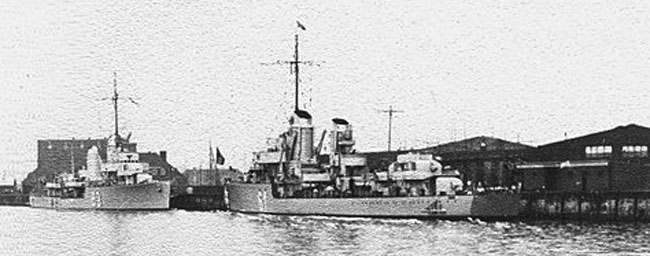
Destroyers Bernd von Arnim and Wolfgang Zenker in Bremerhaven, 1938.
Also called Leberecht Maas class after the lead ship, this was a radical departure over all previous German designs. This new class flirted with 3200 tons limits fully loaded, being twice as large as the previous 23/24 classes of the Reichsmarine. In addition to large dimensions, they had a wide and very marine prow, and a square stern. Their tonnage and size were slightly above International standards, but their armament remained standard with regard to treaties. They were handsome, powerful and fast (almost 40 knots as shown in tests for some).
The series Z1 to Z4 was designed in 1933-34 and launched in 1935. All had a straight prow, converted into a clipper prow from 1943 for the sole survivor Z4 (Richard Beitzen). The Z1 class served as pre-series for the next 1934A class. The next 1934A included the Z5 to Z16.
Launched in 1936-37 and finished in 1937-39, they were longer by 1.70 meters. All had also a straight prow, but in 1943 the Z5 and Z6 had a clipper bow, rising to 125 meters in length, and a tripod main mast. The Z5 (above), will see its armament AA reinforced by 4 bofors of 40 mm, 12 guns of 20 and 4 of 37mm in double shafts.

Z5 of the 1934A class, May 1941
They survived the war and two became the French Kleber and Desaix, remaining in service until 1951 and 1957. The Z9, 11, 12 and 13 will be sunk during operations in Norway in 1940, the Z7 sunk by HMS Edinburgh in 1942 During the attack of a convoy and the Z16 by HMS Sheffield during similar circumstances in December 1942. The Z8 was blown by a mine in January 1942 near Calais. The Z1 and Z3 were sunk in February 1940 by mines and the Z2 at Narvik in April. The Z4 survived the war and was given to UK as war reparations, soon BU.
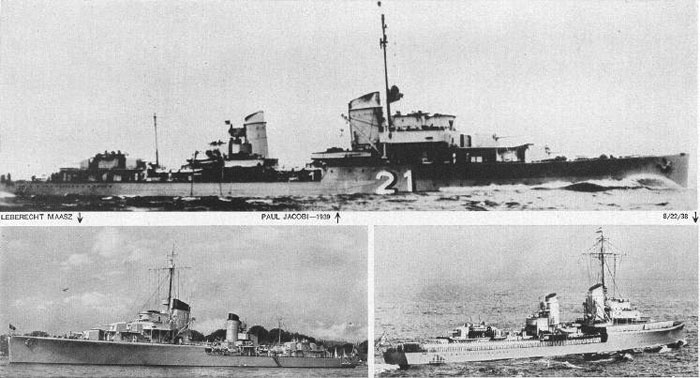
1934 Type, various destroyers

Z1 as built, wikipedia commons, uploaded by Alexpl.
1934A Type specifications |
|
| Dimensions | 121 x 11.30 x 3.90 m (119,70m 1934 class) |
| Displacement | 1625/3165t FL |
| Crew | 315 |
| Propulsion | 2 geared steam turbines Wagner/Blohm & Voss, 6 Wagner/Benson boilers, 70 000 hp. |
| Speed | 38,4 knots (71 km/h; 44 mph) Radius 2000 Nautical Miles |
| Armament | 5x 127 mm, 4x 37mm AA, 4x 20mm AA, 8 TT 533 mm |
1936/36A class: Z17-22, Z23-30
Modern ships derived from class 1934a but larger. The serie 1936 comprised the Z17, 18, 19, 20, 21, 22. They were completed in 1938-39. The first three had a straight bow and the other three had a clipper one and so raised from 123 to 125 meters. They were also wider by 50cm, with a 300 tons more of displacement. They were also more powerful and faster (40 knots versus 38.2), had a better AA artillery. All survivors except the Z20 survived the war and were handed over to the Soviets. However four would be famously sunk at Narvik, Z21 and 22 on April 10 and Z17, 18 and 19 on April 14, 1940 all by the battleship HMS Warspite.
The eight ships of the following class 1936A (Z23-Z30) were brand new in 1940. They were launched from December 1939 to December 1940 and completed in the end of 1940 for the first and 1941 for the others. They are (often) referred to as the “Narvik” class because they were mostly assigned to the 8 destroyers’ squadron based in Narvik from 1941 to 1944 and had nothing to do with the fighting of early 1940. Of the main changes, they all had a clipper bow, were slightly longer, their displacement increasing and their speed logically returning to 38.5 knots.

Z30 in may 1943

Z20 in 1940
On the other hand, they were heavily armed for destroyers, with 4 guns of 150 mm, usually reserved for light cruisers. In 1941, the Z28 received a modified command superstructure, and the Z30 a flight deck over its rear torpedo tubes, designed to operate a Flettner reconnaissance helicopter. The Z25s and 29s received a “Barbara” AA configuration, including 12 guns of 37 mm in single mounts and 18 of 20 mm in double and quadruple mounts. The Z26 was sunk during a 1942 convoy attack, and the Z27 in 1943 during a Homeric fight against the cruisers HMS Glasgow and Enterprise, “opening the way” to the Alsterufer blockade force. The Z24 was sunk by the RAF in 1944.
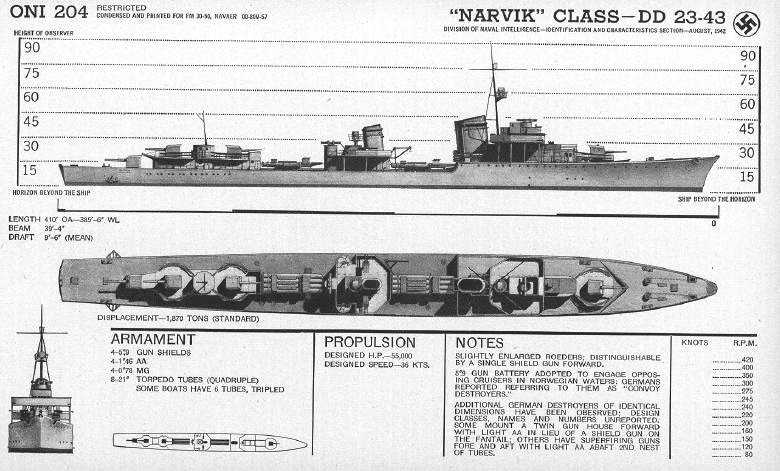
The so-called “Narvik” class was not yet operational when the Norwegian campaign started.
1936 Type specifications |
|
| Dimensions | 123.20 x 11.80 x 4 m |
| Displacement | 1811 standard, 3415t FL |
| Crew | 1600 |
| Propulsion | like type 1934 but 70,000 hp |
| Speed | 40 knots (74 km/h, 46 mph) Radius 2,050 nmi (3,800 km; 2,360 mi) |
| Armament | Like Type 1934, but 7x 20mm AA |
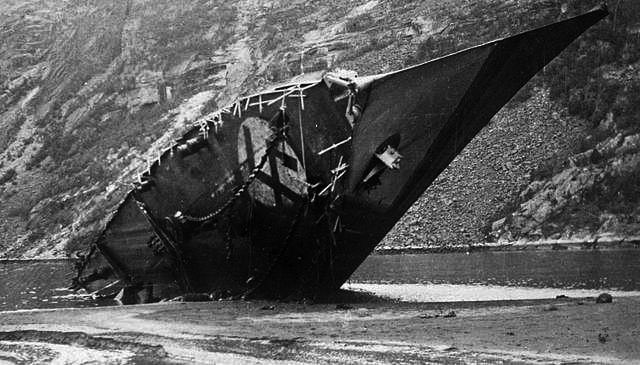
Destroyer brendt Von Arnim wreck, sunk in Oslofjord by the Warspite and scuttled.
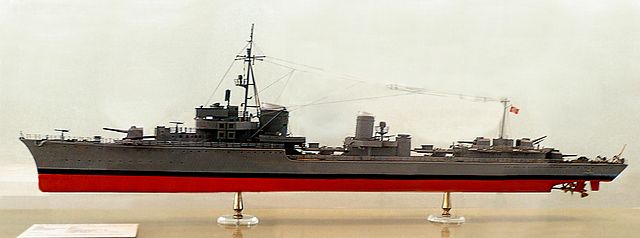
Shipyard Model of the 1936A class on display at the Deutschen Schiffahrtsmuseum Bremerhaven
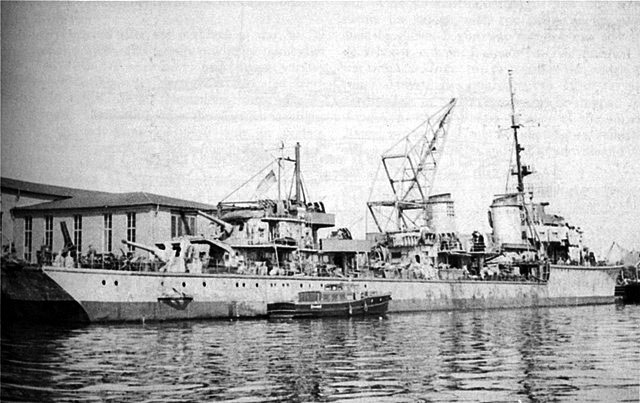
Z-29, type 36A in 1945 (USN photo).
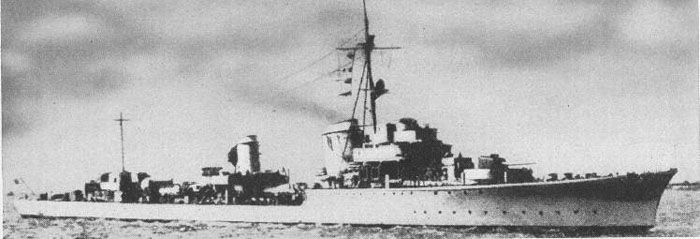
1936A destroyer shortly after completion.

1936A destroyer – booklet for identification of ships, published by the Division of Naval Intelligence of the Navy Department of the United States.
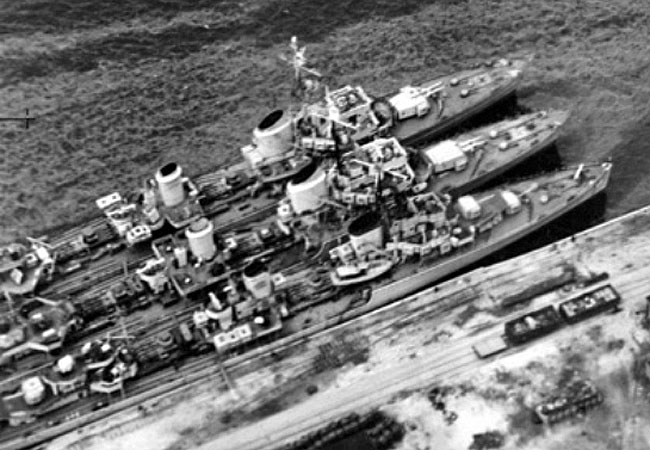
Three Type 36A in an unindentified port (Australian Archives)
Mobilization class: Z31-39

Z39 underway off Boston, September 1945
Derived from class 1936A, these 7 units (Z31-Z34 and Z37-Z39, the Z35 and 36 being reported to type 1936b), were part of the mobilization program (“Mob”). They were launched in 1941 and completed in 1942. They were virtually identical to the previous ones except for their armament, with a heavy 150 mm double turret forward. These ships were far superior to their allied counterparts. Their 20 mm AA batteries were split into two of the new quadruple mounts and two singles. The Z32 was the only loss in action during the war, and was seriously damaged by the Canadian destroyers HMCS Haida and Huron in June 1944 off the lower island. The Z34 and 37 were scuttled in 1944-45 and the others went as war reparations after the war to France (Marceau), Great Britain, the USA (Z39) and the USSR.

Z32 in April 1942

Z35 in 1942
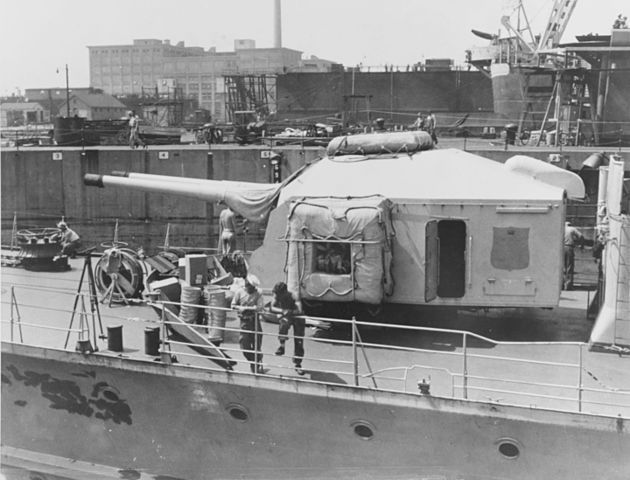
Closeup of the Z39 artillery – USN Archives, Boston NY.
1936A Type specifications |
|
| Dimensions | 127 x 12 x 3.92-4.62 m |
| Displacement | 3600t FL (3530t Z25,26,27) |
| Crew | 321 |
| Propulsion | Like 1934 class but 70,000 hp |
| Speed | 38,5 knots Radius ?? Nautical Miles |
| Armament | 4x 150 mm, 6×2 105mm, 2×2 37mm AA, 5x 20mm AA, 2×4 TT 533 mm |
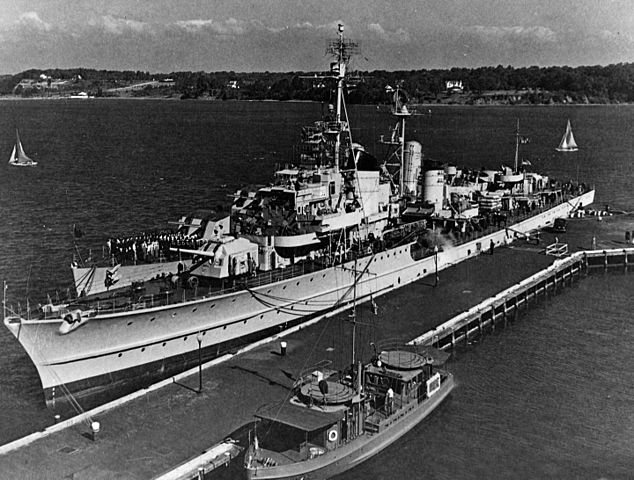
Z39 in Annapolis, 1945.
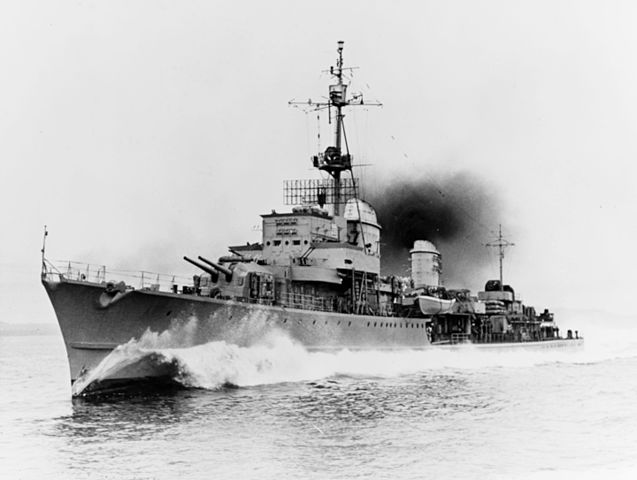
Nice photo of an handsome destroyer, Z39 at full speed.
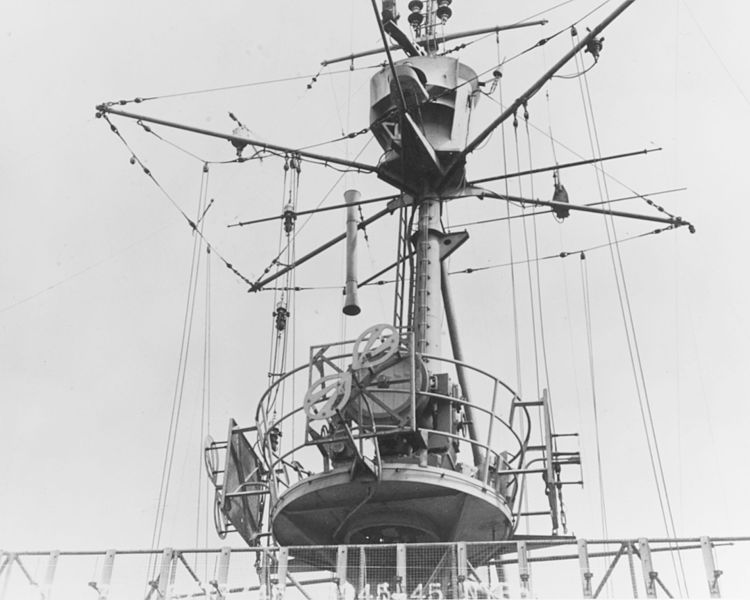
Details of the mast of the Z39, 1936(mob) type in 1945.
More: https://commons.wikimedia.org/wiki/Category:Z_39_(ship,_1941)
Unfinished projects
Wartime was not tender for surface ships building program, and despite the plan Z new series being approved and ordered to various shipyard, lack of manpower and soon materials, sabotages and shortages of all sorts, plus allied air raids all but condemned these series. Only a few ships were launched, and none but two were really operational.
1936B class: Z35-45
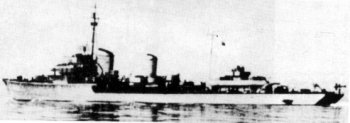
Z36 at sea, 1942
The Type 1936B destroyers abandoned the twin 15-centimetre (5.9 in) turrets because of stability concerns in heavy seas. They reverted to five single 15 cm (5.9 in) turrets and had better AA artillery, but for other aspects remained copies of the 1936A class. At 2,527 tonnes (2,487 long tons) of displacement they still can reach 36.5 knots (67.6 km/h; 42.0 mph) with a 2,600 nautical miles range at 19 knots (35 km/h; 22 mph). The 12.7 cm SK C/34 naval guns fired 28-kilogram (62 lb) HE shells at 830 m/sec. up to 17,400 metres at 30° max. elevation. like previous classes they had rails long enough to laid 76 mines.
Of the eight ships laid down at DeSchiMAG Bremen and Germania Werft of Kiel, only a few were completed: Z35, 36 and Z43, although the latter was scuttled in situ on 3 May 1945 after being commissioned on 24 March 1944. The first two were commissioned on 22 September 1943 and 19 February 1944 and sunk in December 1944 in the Gulf of Finland after hitting friendly mines. Z44 and 45 were bombed by the RAF before completion.
1936B Type specifications |
|
| Dimensions | 127 x 12 x 4.21 m |
| Displacement | 3100/3540 t FL |
| Crew | 330 |
| Propulsion | 2 Wagner shaft geared turbines, 70,000 shp |
| Speed | 36.5 knots (42.0 mph; 67.6 km/h) range 2,600 nmi (4,800 km)@ 19 kn (35 km/h) |
| Armament | 5x 127 mm, 4-10x 37 mm, 16x 20mm AA, 8(2×4) TT 533 mm |
1940/41 scout cruiser class: German super-destroyers

Spährkreuzer design, rendition by Atlas publications, 1984
Classed as scout cruisers/destroyers they took advantage of the artillery developed for the 1936A class, with a 6300t displacement. Studies for these get back to the 1938 Z plan. After the cancellation of the 1938B type, these three ships were planned as “spährkreuser” 1 to 3. The first, Sp1, was laid down at Germaniawerft in 1941 but work was suspended and she was eventually broken up on slip to be recycled into other ships. The Sp2 and 3 were planned but never started.
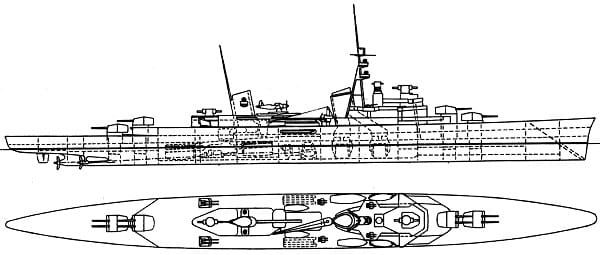
1st design, with a floatplane. scr: unknown
How these unique “scout-cruisers” looked like ?: They were 162-169 m long by 16m wide with 4.90 draught, had three shaft and two geared turbines plus four Wagner boilers that gave an output in excess of 80,00 hp for a top speed of 36 knots, cruise and long range being assured by two MAN diesels, double acting 2-stroke, producing 32,000 hp on the central shaft. complement was 520 and they were armed with three turrets with 150 mm/48 guns, two 88mm AA guns, and 12 20mm AA guns in quad-mounts plus two banks of five 533 mm TTs.
1940 Type specifications |
|
| Dimensions | 162 x 16 x 4.9 m |
| Displacement | 6300t FL |
| Crew | 520 est. |
| Propulsion | 3 screws, 2 geared turbines, 4 Wagner boilers 80,000 hp |
| Speed | 36 knots |
| Armament | 6(2×3)x 150 mm, 2x 88 mm, 12x 20mm AA, 2×5 TT 533 mm |
1936C class: The 128mm dual purpose destroyers
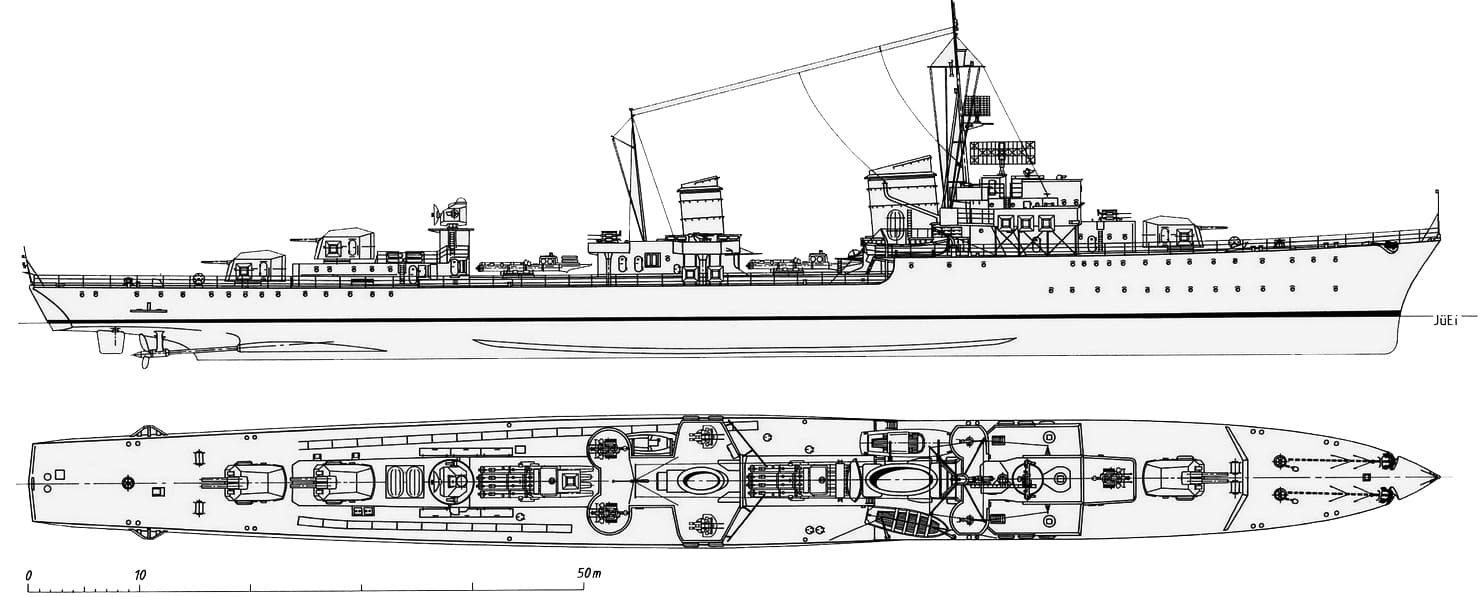
German reconstitution of the 1936C class design – JüEi
Although relatively conventional in general layout these destroyers relied on a set of three double turrets with brand new 128mm guns, dual-purpose, meaning they had enough elevation and speed to tackle aircraft as well, a powerful asset by the time allied air superiority seems to be the most present threat for the German Navy. This was completed by three twin 37mm/83 and six 20mm mounts, plus the usual quadruple TT mounts. At 3030t standard, these 1936C were 500 tons heavier than the previous 36B, but kept the same propulsion system with Wagner turbines and boilers, and same 38 knots top speed. Five ships were to be built in 1943 at Deschimag of Bremen from Z46 to Z50, but due to the shortage of materials and relentless allied bombings, construction stalled and was eventually abandoned in 1944, while the ships were broken up in 1946.
1936C Type specifications |
|
| Dimensions | 126,20 x12.20 x 4 m |
| Displacement | 3030/3594t FL |
| Crew | 320 |
| Propulsion | 2 Wagner shaft geared turbines, 6 Wagner boilers 70,000 hp |
| Speed | 38 knots |
| Armament | 6(3×2)x 128 mm DP, 6×2 37mm AA, 6x 2mm AA, 8(2×4) TT 533 mm |
1942 class: The diesel experiment
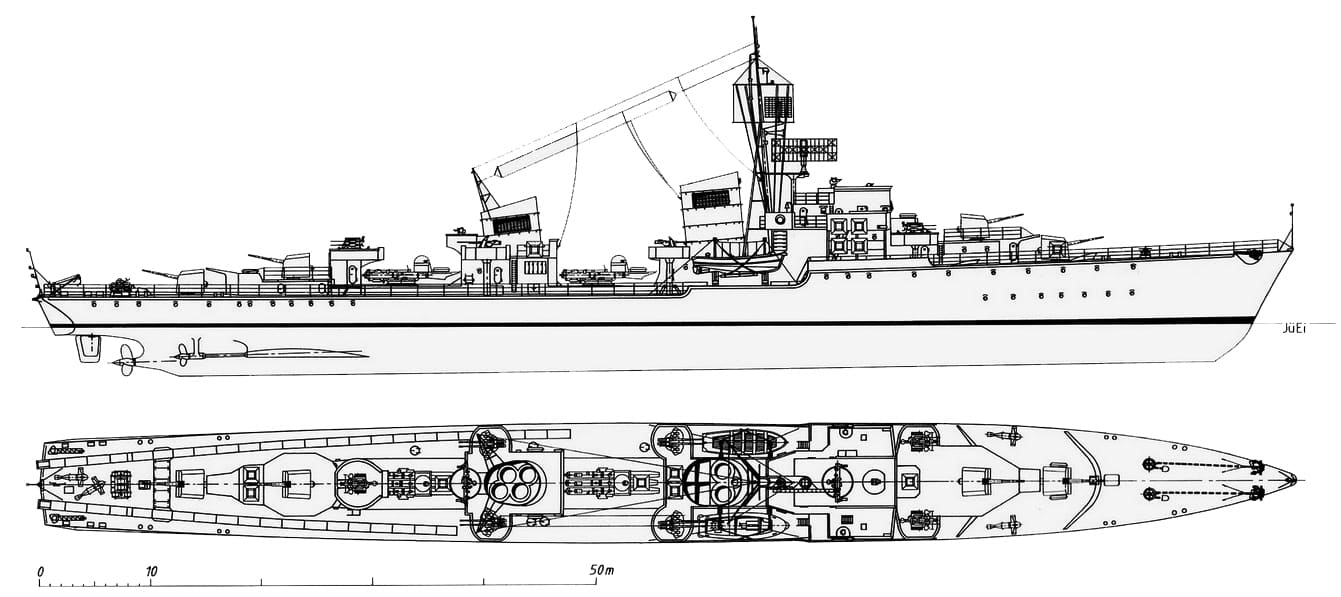
German reconstitution of the 1942 class design – JüEi
Turbines procured advantages in terms of speed but were also known gas-guzzlers and could be troublesome as experience with the Hipper shown. A type of destroyer was launched to test an all-diesel propulsion while not sacrificing speed, but for the sake of reliability and range. The 1942 type was not however daring in layout which remains consistent with previous designs, but somewhat smaller and lighter and less well-armed than previous classes. Mass production was also in mind. The powerplant consisted in six diesels, four one the central shaft and one for each outer shaft, totaling 57,000 hp. AA artillery was impressive with four twin 37mm 83 cal. M42, and three quadruple mounts 20mm C38 FLAK.
The single Z51 was started at Deschimag, launched in 1944 and its completion was well advanced when an air raid all but destroyed it. Never repaired, the hull lays untouched until she was broken up in situ in 1946.
1942 Type specifications |
|
| Dimensions | 114,30 x 11 x 4 m |
| Displacement | 2330/2630t FL |
| Crew | 235 |
| Propulsion | 3 shafts, 6V double acting 2-stroke diesels 57,120 hp |
| Speed | 36 knots |
| Armament | 4x 127 mm, 4×2 37mm AA, 3×4 20mm AA, 8(2×4) TT 533 mm |
1944 class: The most modern

Impression of the 1944 class design – combo JüEi
Capitalizing on the new tendency to built all-diesel powered destroyers, the new 1944 type is generally considered by experts and historians as the most modern class of destroyers (perhaps worldwide) at that time, a culmination of the Z-type started ten years ago. In addition to larger dimensions than the previous type 1942, these new kids on the block had a whole set of features that were way ahead of previous designs. For starters, they combined a powerful punch with three turrets, for six of the new and successful, semi-auto, rapid fire 128mm/50 and /45 C41M, their next evolution.
These were deadly accurate dual purpose guns, well served by advanced, radar-guided fire control systems. These guns were the navalized version of the Flakwilling 40, a gun that all but eclipsed the legendary 88mm late into the war. Some experts esteemed these would have been more likely fully automatic cannons. Second, they would have the new 55mm mid-range quick-firing Flak Gerät 58 in development (eventually rejected by Hitler and Speer for the Army).
At last, they also get rid of their combination of 37 and 20mm for short range, swapping over a brand new, revolutionary superfast fully automated 30mm gun/13 C38 also rejected by the Army, in no less than 14 mounts. The entire battery was directed by optical/electronic range-finder cupolas. The powerplant consisted in eight MAN diesels, double-acting two-stroke delivering 76,000 on two shafts, for a top speed of 37.5 knots, nearly the same speed as turbine destroyers, which was a remarkable feat for the advantages this solution procured in terms of range and reliability. Five ships were ordered and started at Deschimag, Bremen in early 1944, but due to intense allied bombings and shortages, none even reached launching point. The hulls were dismantled in 1946.
1944 Type specifications |
|
| Dimensions | 132.10 x 12.60 x 4.30 m |
| Displacement | 3170/3703t FL |
| Crew | 308 |
| Propulsion | 2 shafts, 8 MAN double acting 2-stroke diesels 76,000 hp |
| Speed | 37.5 knots |
| Armament | 3×2 128 mm DP, 3x 55m AA, 14x 30mm AA, 8(2×4) TT 533 mm |
Paper Projects
According to http://german-navy.de there were paper-only destroyers projects that also deserve attention:
Zerstörer 1938A/Ac : In 1937/38 a large Atlantic destroyer was studied, about 50% larger than usual classes they also had a mixed propulsion reminiscent of the Köln and Leipzig, missing Diesels and turbines and a light armor protection. Z-plan included 24 of these, and 10 were programmed for 1943, the remainder to be delivered until 1945, but the program was cancelled in 1939, and some of these studies were recycled into the larger Spähkreuzer. Their appearance was very singular, with three 128mm turrets (for and aft and one center next to the two TT banks, a twin 105mm AA mount, several 37mm twin mounts and probably 20mm mounts also, and funnels far apart.
Zerstörer 1938B : These were in appearance large torpedo boats, with their characteristic flush deck, but were designed for the coastal waters and especially the Baltic Sea. This 1938 design was small, but well armed with two 128 mm armed turrets, two banks of three TTs but a weak AA artillery. 12 were planned within Z plan in the summer of 1939, only to be cancelled three weeks after the beginning of the war.
Zerstörer 1945 : This very last class of destroyer was studied in 1945, amidst devastating air raids and low priority that left little chance for the ships to be built, if any. Nevertheless these destroyers on paper looks interesting. They were compact, reverted to a full steam turbine power for extra speed, well armed with three 128mm turrets and an impressive AA battery reminiscent of the type 1944, and the same optical/electronic range-finder cupolas and advanced radar-guided controlled systems. Needless to say no order ever came for a production.
Sources:
Conway’s all the world fighting ships 1921-1947.
deutschekriegsmarine.de
http://german-navy.de/kriegsmarine/ships/destroyer/index.html

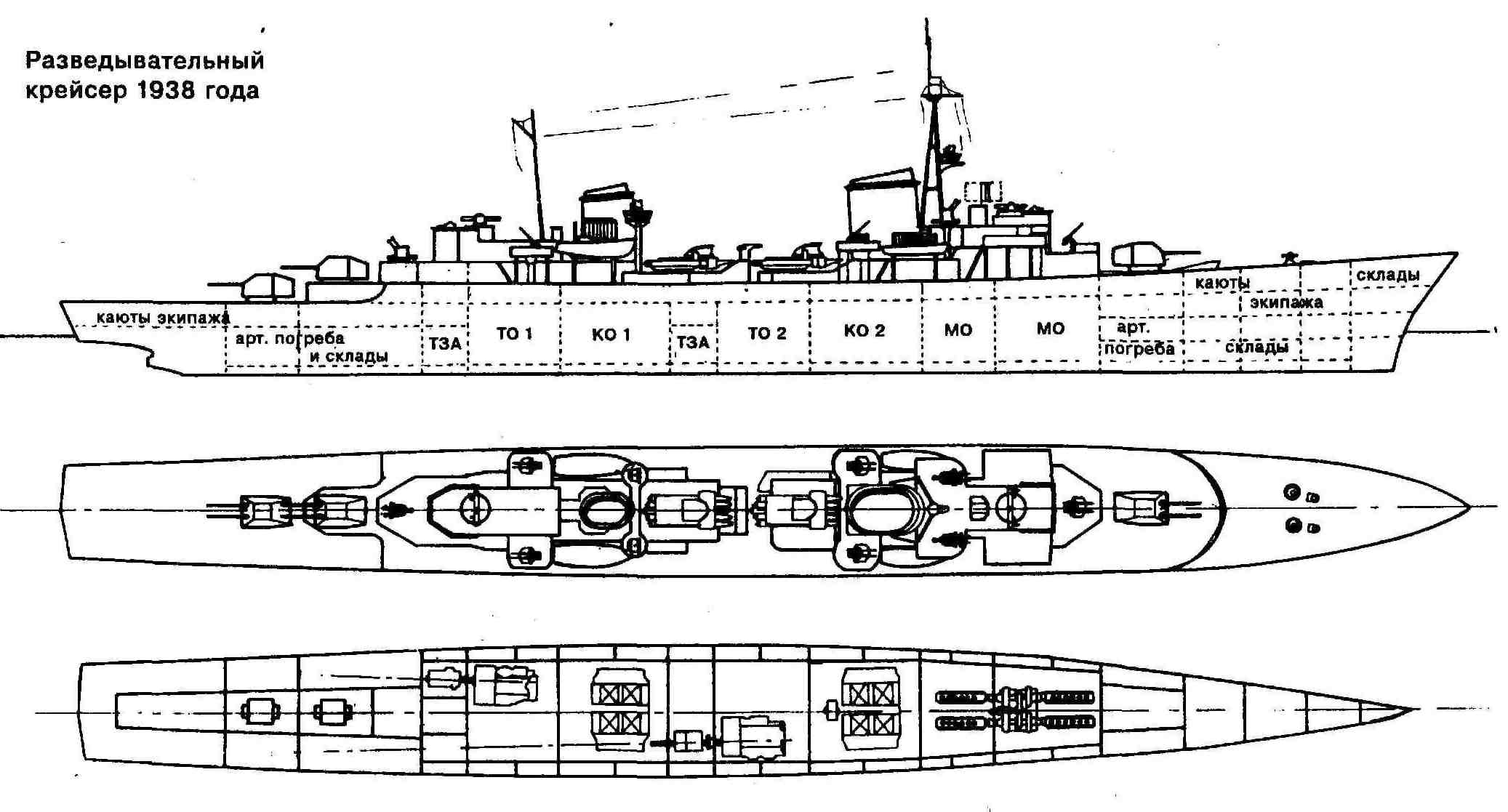
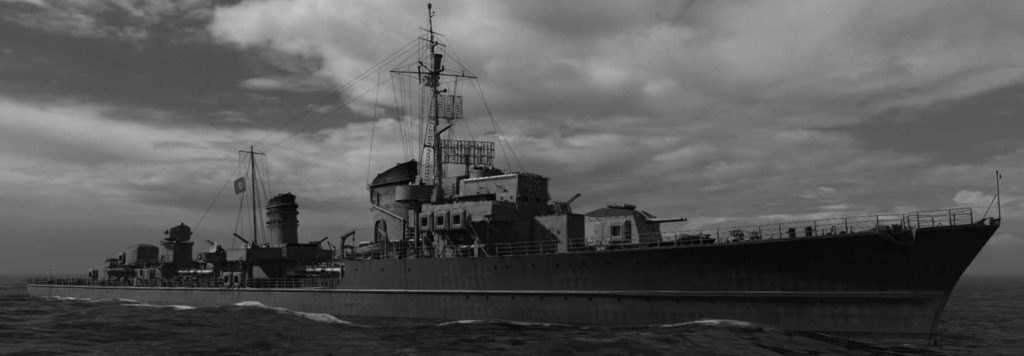
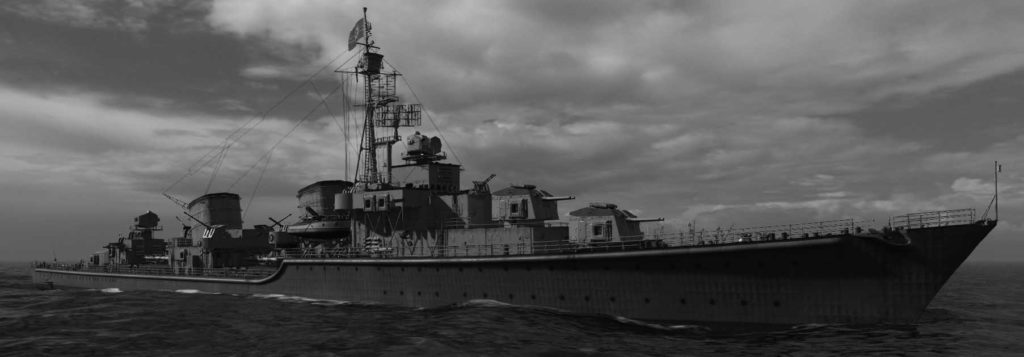
 Latest Facebook Entry -
Latest Facebook Entry -  X(Tweeter) Naval Encyclopedia's deck archive
X(Tweeter) Naval Encyclopedia's deck archive Instagram (@navalencyc)
Instagram (@navalencyc)





 Austrian Navy
Austrian Navy French Navy
French Navy Royal Navy
Royal Navy Armada Espanola
Armada Espanola K.u.K. Kriegsmarine
K.u.K. Kriegsmarine Dansk Marine
Dansk Marine Nautiko Hellenon
Nautiko Hellenon Koninklije Marine 1870
Koninklije Marine 1870 Marinha do Brasil
Marinha do Brasil Osmanlı Donanması
Osmanlı Donanması Marina Do Peru
Marina Do Peru Marinha do Portugal
Marinha do Portugal Regia Marina 1870
Regia Marina 1870 Nihhon Kaigun 1870
Nihhon Kaigun 1870 Preußische Marine 1870
Preußische Marine 1870 Russkiy Flot 1870
Russkiy Flot 1870 Svenska marinen
Svenska marinen Søværnet
Søværnet Union Navy
Union Navy Confederate Navy
Confederate Navy Armada de Argentina
Armada de Argentina Imperial Chinese Navy
Imperial Chinese Navy Marinha do Portugal
Marinha do Portugal Mexico
Mexico Kaiserliche Marine
Kaiserliche Marine 1898 US Navy
1898 US Navy Russkiy Flot
Russkiy Flot French Naval Aviation
French Naval Aviation Russian Naval Aviation
Russian Naval Aviation Sovietskiy Flot
Sovietskiy Flot Royal Canadian Navy
Royal Canadian Navy Royal Australian Navy
Royal Australian Navy RNZN Fleet
RNZN Fleet Chinese Navy 1937
Chinese Navy 1937 Kriegsmarine
Kriegsmarine Chilean Navy
Chilean Navy Danish Navy
Danish Navy Finnish Navy
Finnish Navy Hellenic Navy
Hellenic Navy Polish Navy
Polish Navy Romanian Navy
Romanian Navy Turkish Navy
Turkish Navy Royal Yugoslav Navy
Royal Yugoslav Navy Royal Thai Navy
Royal Thai Navy Minor Navies
Minor Navies Albania
Albania Austria
Austria Belgium
Belgium Columbia
Columbia Costa Rica
Costa Rica Cuba
Cuba Czechoslovakia
Czechoslovakia Dominican Republic
Dominican Republic Haiti
Haiti Hungary
Hungary Honduras
Honduras Estonia
Estonia Iceland
Iceland Eire
Eire Equador
Equador Iran
Iran Iraq
Iraq Latvia
Latvia Liberia
Liberia Lithuania
Lithuania Mandchukuo
Mandchukuo Morocco
Morocco Nicaragua
Nicaragua Persia
Persia San Salvador
San Salvador Sarawak
Sarawak Uruguay
Uruguay Venezuela
Venezuela Zanzibar
Zanzibar Warsaw Pact Navies
Warsaw Pact Navies Bulgaria
Bulgaria Hungary
Hungary

 Bundesmarine
Bundesmarine Dutch Navy
Dutch Navy Hellenic Navy
Hellenic Navy Marina Militare
Marina Militare Taiwanese Navy
Taiwanese Navy Chinese Navy
Chinese Navy Indian Navy
Indian Navy Indonesian Navy
Indonesian Navy JMSDF
JMSDF North Korean Navy
North Korean Navy Philippines Navy
Philippines Navy ROKN
ROKN IDF Navy
IDF Navy Royal New Zealand Navy
Royal New Zealand Navy Egyptian Navy
Egyptian Navy South African Navy
South African Navy

































 RN
RN
 Marine Nationale
Marine Nationale
 Soviet Navy
Soviet Navy
 dbodesign
dbodesign